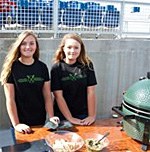Don’t Take Your Food For ‘Granite’
 This breakfast plate at the Lizzadro Museum of Lapidary Art, 220 Cottage Hill Ave. Elmhurst, Illinois (map), may look edible, but it’s not.
This breakfast plate at the Lizzadro Museum of Lapidary Art, 220 Cottage Hill Ave. Elmhurst, Illinois (map), may look edible, but it’s not.
Everything on the plates is stone — logical in a museum established to share the beauty of gemstones and promote the study of earth science.
As Sara Johnson writes in the museum’s newsletter, “Minerals are defined as solid compounds derived from geologic processes. Rocks are aggregates of minerals that are found in the earth’s crust. Together rocks and minerals contribute to everything on the earth, from the water we drink, to the plants we harvest, to the livestock we raise.
“Even our bodies are made of mineral.! Our teeth and bones are made of calcite and apatite, minerals composed of the elements calcium and phosphorus. Our sweat contains salt, which is the mineral halite and is composed of the elements sodium and chlorine. We even have iron in our blood to help carry oxygen to our organs.”
So, while these “meals” aren’t for eating, they are for “thinking” about the “dynamic relationship between the earth’s rock cycle and the food cycle,” as Ms. Johnson says. (Gives a whole new meaning to “stone soup”.)
Take a look at more of the “food”:
(Photos ©2013 by Susan McKee)
























